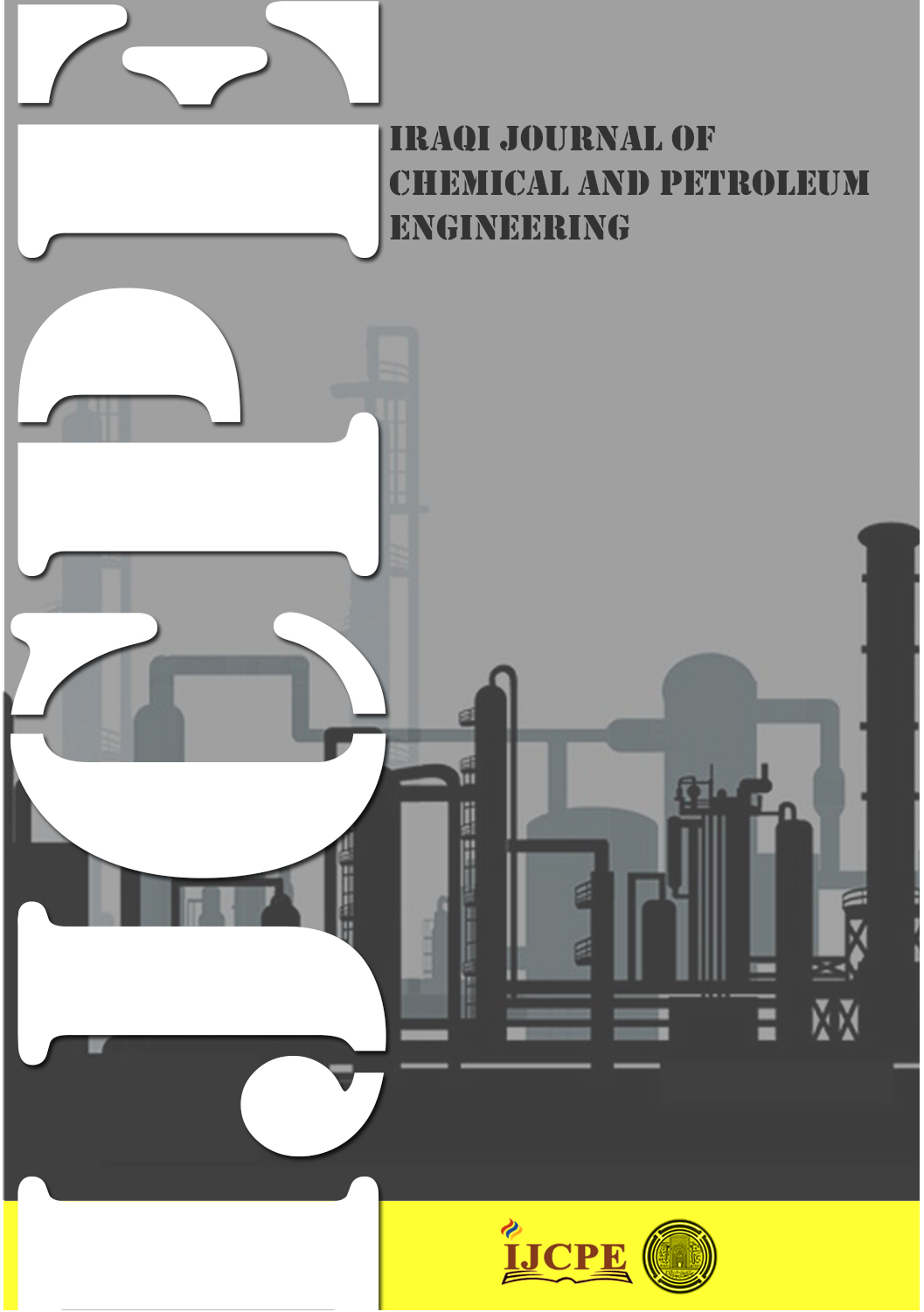Evolution of the biological effect of synthesized zinc-iron oxides nanoparticles on organic pollutants in drinking water
DOI:
https://doi.org/10.31699/IJCPE.2025.1.12Keywords:
biosynthesis; nanoparticles; organic pollutants; Zinc oxide; Iron oxideAbstract
This study aimed to explain the biosynthesis process of Zinc and Iron oxide nanoparticles (Zn- O+ Fe- ONPs) using an extracellular enzyme, which in turn produced from particular environmental bacteria isolates Escherichia coli a stabilizing and reducing agent. Biosynthesized (ZnO+FeO) nanoparticles have presented many applications such as catalysis, biosensing, anticancer, and biomedical, etc. The optimum condition for Zn-O and Fe-O biosynthesis was characterized through several techniques such as UV-Vis, AFM, XRD, FT-IR, and FE-SEM. In particular, a cut-off phenomenon of the biological synthesized Zn-O and Fe-O was found at around 287 nm using UV-Vis, while spherical shape particles were noticed using FE-SEM techniques. Also, the AFM analysis revealed that Zn-O and Fe-O NPs have an average diameter size of 75.03 nm. Determine the FTIR spectrum of the biosynthesized Zn-O and Fe-O nanoparticles showing Zn-O at the broad peak at 509.17-426.24 cm. Where the study shows the best removal of organic pollutants after using the nano-mix oxides of the following organic pollutants (Henecosaine, Eicosane, Tridecane, Docosane, Tetradecane) The removal percentage was straight (6.13-2,34-0,49-1.87-0,84%). After measuring the drinking water sample before and after using the nanoparticles with the GC-Mass device. The best percentage for removing inorganic pollutants of (Pb, Cr, Cu) after treatment mixture nanoparticles, and the removal percentages were respectively (12.24-1.37-0.44%). As for (Cd, Al) the percentage was respectively (8.11-3.94) after using the nanoparticles with the ICP-EOS device.
Received on 04/06/2023
Received in Revised Form on 08/10/2023
Accepted on 08/10/2023
Published on 30/03/2025
References
[1] A. S. Abdelbaky, T. A. Abd El-Mageed, A. O. Babalghith, S. Selim, and A. M. Mohamed, "Green synthesis and characterization of ZnO nanoparticles using Pelargonium odoratissimum (L.) aqueous leaf extract and their antioxidant, antibacterial and anti-inflammatory activities," Antioxidants, vol. 11, no. 8, p. 1444, 2022. https://doi.org/10.3390/antiox11081444
[2] S. Afolalu, O. Ikumapayi, M. Emetere, and S. Ongbali, "Investigation of mechanical properties and characterization of a joint using nano flux powder for a-tig welding," Materials Today: Proceedings, vol. 44, pp. 2879-2883, 2021. https://doi.org/10.1016/j.matpr.2021.01.091
[3] H. A. Alalwan, S. E. Mason, V. H. Grassian, and D. M. Cwiertny, "α-Fe2O3 nanoparticles as oxygen carriers for chemical looping combustion: an integrated materials characterization approach to understanding oxygen carrier performance, reduction mechanism, and particle size effects," Energy & fuels, vol. 32, no. 7, pp. 7959-7970, 2018. https://doi.org/10.1021/acs.energyfuels.8b01539
[4] H. Agarwal, S. Menon, S. V. Kumar, and S. Rajeshkumar, "Mechanistic study on antibacterial action of zinc oxide nanoparticles synthesized using green route," Chemico-biological interactions, vol. 286, pp. 60-70, 2018. https://doi.org/10.1016/j.cbi.2018.03.008
[5] M. Ajith, M. Aswathi, E. Priyadarshini, and P. Rajamani, "Recent innovations of nanotechnology in water treatment: A comprehensive review," Bioresource Technology, vol. 342, p. 126000, 2021. https://doi.org/10.1016/j.biortech.2021.126000
[6] A. A. Al Awadh et al., "Sustainable synthesis and characterization of zinc oxide nanoparticles using Raphanus sativus extract and its biomedical applications," Crystals, vol. 12, no. 8, p. 1142, 2022. https://doi.org/10.3390/cryst12081142
[7] S. A. Mohammed, I. Faisal, and M. M. Alwan, "Oily wastewater treatment using expanded beds of activated carbon and zeolite," Iraqi Journal of Chemical and Petroleum Engineering, vol. 12, no. 1, pp. 1-12, 2011. https://doi.org/10.31699/IJCPE.2011.1.1
[8] S. Al-Ghamdi et al., "Green synthesis and characterization of zinc oxide nanoparticles using Camellia sinensis tea leaf extract and their antioxidant, anti-bactericidal and anticancer efficacy," Research on Chemical Intermediates, vol. 48, no. 11, pp. 4769-4783, 2022. https://doi.org/10.1007/s11164-022-04845-z
[9] K. Ali et al., "Aloe vera extract functionalized zinc oxide nanoparticles as nanoantibiotics against multi-drug resistant clinical bacterial isolates," Journal of colloid and interface science, vol. 472, pp. 145-156, 2016. https://doi.org/10.1016/j.jcis.2016.03.021
[10] A. Alangari et al., "Iron oxide nanoparticles: preparation, characterization, and assessment of antimicrobial and anticancer activity," Adsorption Science & Technology, vol. 2022, 2024. https://doi.org/10.1155/2023/9840478
[11] L. Yaaqoob, "EVALUATION OF THE BIOLOGICAL EFFECT SYNTHESIZED IRON OXIDE NANOPARTICLES ON ENTEROCOCCUS FAECALIS," IRAQI JOURNAL OF AGRICULTURAL SCIENCES, vol. 53, no. 2, pp. 440-452, 2022. https://doi.org/10.36103/ijas.v53i2.1552
[12] M. Barbooti et al., "Evaluation of quality of drinking water from Baghdad, Iraq," Science World Journal, vol. 5, no. 2, 2010. https://doi.org/10.4314/swj.v5i2.61512
[13] Y. Li, J. Li, P. Qiao, D. Zhou, Y. Xing, and J. Chen, "Monitoring the volatile composition and change in different geographical regions and harvest time of Chinese truffle (Tuber indicum Cooke & Massee)," European Food Research and Technology, vol. 248, no. 6, pp. 1663-1677, 2022. https://doi.org/10.1007/s00217-022-03994-0
[14] S. Yamamura, J. Bartram, M. Csanady, H. G. Gorchev, and A. Redekopp, "Drinking water guidelines and standards," Arsenic, water, and health: the state of the art, 2003.
[15] B. Pant, G. P. Ojha, Y.-S. Kuk, O. H. Kwon, Y. W. Park, and M. Park, "Synthesis and characterization of ZnO-TiO2/carbon fiber composite with enhanced photocatalytic properties," Nanomaterials, vol. 10, no. 10, p. 1960, 2020. https://doi.org/10.3390/nano10101960
[16] Bharti, J. Jangwan, G. Kumar, V. Kumar, and A. Kumar, "Abatement of organic and inorganic pollutants from drinking water by using commercial and laboratory-synthesized zinc oxide nanoparticles," SN Applied Sciences, vol. 3, pp. 1-12, 2021. https://doi.org/10.1007/s42452-021-04294-0
[17] H. M. Ibrahim, "Study the optimization of petroleum refinery wastewater treatment by successive electrocoagulation and electro-oxidation systems," Iraqi Journal of Chemical and Petroleum Engineering, vol. 23, no. 1, pp. 31-41, 2022. https://doi.org/10.31699/IJCPE.2022.1.5
[18] R. Ali, Z. J. Shanan, G. M. Saleh, and Q. Abass, "Green synthesis and the study of some physical properties of MgO nanoparticles and their antibacterial activity," Iraqi Journal of Science, pp. 266-276, 2020. https://doi.org/10.24996/ijs.2020.61.2.9
[19] H. Hussain, M. Mahmood, and L. Yaaqoob, "The Biological Effect of Synthesized Zinc Oxide Nanoparticles on Organic Pollutions in Drinking Water," Iraqi Journal of Science, 2024. https://doi.org/10.24996/ijs.2024.65.8.10
Downloads
Published
Issue
Section
License
Copyright (c) 2025 The Author(s). Published by College of Engineering, University of Baghdad.

This work is licensed under a Creative Commons Attribution 4.0 International License.













